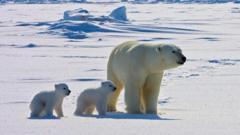A recent study indicates that polar bears are at a heightened risk of contracting diseases in a warming Arctic, with increased exposure to pathogens linked to the loss of sea ice and habitat changes over the past 30 years, raising urgent concerns for their population and ecosystem health.
Polar Bears at Increased Risk of Disease due to Warming Arctic

Polar Bears at Increased Risk of Disease due to Warming Arctic
New research reveals that climate change is leading to higher pathogen exposure in polar bears, signifying troubling shifts in Arctic ecosystems.
Article text:
As the Arctic continues to warm, polar bears are spending an increasing amount of time on land, resulting in a heightened risk of diseases linked to environmental changes. A recent study highlights how these iconic mammals are becoming more susceptible to viruses, bacteria, and parasites that were previously encountered less frequently, particularly over the last 30 years.
Researchers focused their attention on blood samples from polar bears in the Chukchi Sea region, situated between Alaska and Russia. By analyzing samples collected from the years 1987 to 1994 and comparing them with those gathered between 2008 and 2017, the study revealed a troubling rise in the prevalence of disease markers among modern polar bear populations.
Wildlife biologist Dr. Karyn Rode from the US Geological Survey emphasized that these findings underscore significant transformations occurring across the Arctic ecosystem. While assessing the animals' health based on blood samples presents challenges, the data illustrates that environmental changes are closely correlated with increased disease exposure in polar bears.
The study identified six specific pathogens, which include two types of parasites responsible for toxoplasmosis and neosporosis, as well as bacteria that induce rabbit fever and brucellosis, and the virus responsible for canine distemper. Notably, while polar bears typically demonstrate resilience to diseases, the growing presence of these pathogens serves as an alarming indicator of broader ecosystem shifts.
Dr. Rode elaborated that their findings suggest polar bears are increasingly interacting with land species, which increases their exposure to land-based pathogens as the sea ice essential for hunting diminishes. The research indicates that these changes affect not only polar bears but also other wildlife in the Arctic, thereby signifying a more extensive impact on the biological fabric of the region.
Currently, about 26,000 polar bears remain in the wild, primarily found in Canada, with populations also inhabiting the US, Russia, Greenland, and Norway. Classified as "vulnerable" by the International Union for Conservation of Nature, these majestic creatures face mounting threats primarily due to climate change-induced habitat loss. Adult males can grow to nearly 3 meters in length and weigh around 600 kg. With a remarkable sense of smell that allows them to detect prey from up to 16 kilometers away, these bears are also powerful swimmers, capable of covering distances of up to 100 kilometers in search of food.
In the US, polar bears are designated as a threatened species; the ongoing decrease in sea ice, which serves as their primary platform for hunting marine animals, is a critical factor in their declining population. The study underscores the essential connection between climate change, habitat loss, and increased disease exposure that imperils polar bears and the overall health of Arctic ecosystems. The findings are published in the scientific journal PLOS One.
As the Arctic continues to warm, polar bears are spending an increasing amount of time on land, resulting in a heightened risk of diseases linked to environmental changes. A recent study highlights how these iconic mammals are becoming more susceptible to viruses, bacteria, and parasites that were previously encountered less frequently, particularly over the last 30 years.
Researchers focused their attention on blood samples from polar bears in the Chukchi Sea region, situated between Alaska and Russia. By analyzing samples collected from the years 1987 to 1994 and comparing them with those gathered between 2008 and 2017, the study revealed a troubling rise in the prevalence of disease markers among modern polar bear populations.
Wildlife biologist Dr. Karyn Rode from the US Geological Survey emphasized that these findings underscore significant transformations occurring across the Arctic ecosystem. While assessing the animals' health based on blood samples presents challenges, the data illustrates that environmental changes are closely correlated with increased disease exposure in polar bears.
The study identified six specific pathogens, which include two types of parasites responsible for toxoplasmosis and neosporosis, as well as bacteria that induce rabbit fever and brucellosis, and the virus responsible for canine distemper. Notably, while polar bears typically demonstrate resilience to diseases, the growing presence of these pathogens serves as an alarming indicator of broader ecosystem shifts.
Dr. Rode elaborated that their findings suggest polar bears are increasingly interacting with land species, which increases their exposure to land-based pathogens as the sea ice essential for hunting diminishes. The research indicates that these changes affect not only polar bears but also other wildlife in the Arctic, thereby signifying a more extensive impact on the biological fabric of the region.
Currently, about 26,000 polar bears remain in the wild, primarily found in Canada, with populations also inhabiting the US, Russia, Greenland, and Norway. Classified as "vulnerable" by the International Union for Conservation of Nature, these majestic creatures face mounting threats primarily due to climate change-induced habitat loss. Adult males can grow to nearly 3 meters in length and weigh around 600 kg. With a remarkable sense of smell that allows them to detect prey from up to 16 kilometers away, these bears are also powerful swimmers, capable of covering distances of up to 100 kilometers in search of food.
In the US, polar bears are designated as a threatened species; the ongoing decrease in sea ice, which serves as their primary platform for hunting marine animals, is a critical factor in their declining population. The study underscores the essential connection between climate change, habitat loss, and increased disease exposure that imperils polar bears and the overall health of Arctic ecosystems. The findings are published in the scientific journal PLOS One.





















